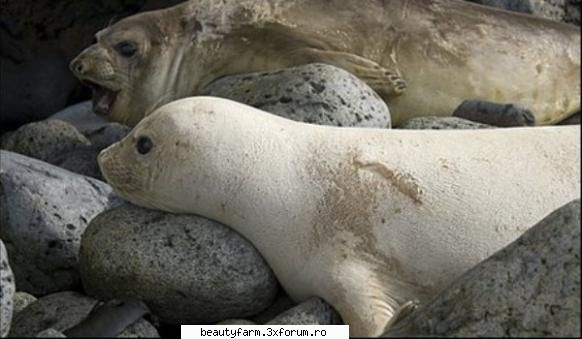ADMIN-ELECTRIK_CAT
Administrator
 Din: CAT LAND
Inregistrat: acum 19 ani
Postari: 8870
|
|
Un exemplar rar: elefantul de mare alb
Pe insula Marion din Oceanul Indian traieste un elefant de mare de culoare alba. Exemplarul a fost descoperit si fotografiat de o echipa de cercetatori sud-africani.
Este primul exemplar alb descoperit intr-o populatie de elefanti de mare sudici, indivizii acestei specii avand, de obicei, corpul de culoare bruna. Printre alte specii de foci, cum sunt otariile si leii de mare, se intampla mai des sa apara exemplare de culori neobisnuite, insa printre elefantii de mare n-au fost semnalati, pana acum, asemenea “ciudati”. Biologii care au zarit si fotografiat mica foca alba – o femela – au fost cu atat mai surprinsi de descoperire, cu cat elefantul de mare sudic (Mirounga leonina) este o specie mult studiata si, prin urmare, binecunoscuta oamenilor de stiinta.
Exemplarul nu sufera de albinism – o afectiune genetica manifestata prin lipsa pigmentului in piele, par si ochi – caci are ochii de culoare normala (in cazul mamiferelor albinoase, ochii apar rosii, deoarece prin irisul lipsit de pigment se vad vasele de sange.) Este vorba, asa cum au afirmat biologii de la Universitatea din Pretoria, Africa de Sud, de un caz de leucism, mica foca fiind nascuta cu o cantitate foarte mica de pigment (de aceea apare aproape alba), dar cu ochii de culoare inchisa. Desi printre elefantii de mare apar uneori exemplare cu o nuanta mai deschisa a blanii, acesta este primul caz de leucism cunoscut la aceasta specie.
Rare white seal caught on camera
A white southern elephant seal has been spotted on a sub-Antarctic beach.
It is the first confirmed sighting of such an animal.
Eared seals, which include sea lions and fur seals are more usually seen sporting unusual colours, but not true seals, a group which includes elephant seals.
Details of the seal, which has creamy white fur but normal brown eyes and nose, have been published in the journal Polar Biology.
"It's quite something in a species which is well-known," says Ryan Reisinger of the University of Pretoria in South Africa, one of the researchers who discovered the animal on Marion Island.
For example, southern elephant seals from many colonies were hunted for decades within the nineteenth and twentieth centuries. In more recent times, scientists have also extensively studied the animals. "Yet this is the first confirmed case of leucism in the species," says Reisinger.
The white seal, a young female, is leucistic, rather than albinistic.
Albino animals lack pigment in just their eyes, or in their eyes, skin and hair, and they inherit the condition. Leucistic animals have little pigment and appear white all over, but with dark coloured eyes.
The white seal has a uniformly creamy white coat of fur, with normal dark brown eyes and nose. Its whiskers, eyebrows and fingernails on its flippers are also light coloured compared to the species' usual dark colour.
"To our knowledge, we're the first to provided detailed evidence of such an animal anywhere," says Reisinger.
The research team sighted the white seal on 23 August 2008 on Whale Bird beach on Marion Island, which lies in the sub-Antarctic region of the Indian Ocean. On 30 August, the researchers saw the seal again and got close enough to confirm its leucism, tag it and take a skin biopsy.
They estimate the animal was between one and two years old, and was likely born either on nearby Prince Edward Island or further afield on Iles Crozet.
Reisinger says it's impossible to say precisely how rare the animal is. "We can't put it in terms of one in a million, or one in a hundred thousand."
But he and his colleagues have been monitoring and tagging elephant seals for years on the island without having seen one. While there have been a few rare previous records of lighter coloured elephant seals, none have been confirmed as leucestic.
The researchers were actually on the look out for leucestic Antarctic fur seals when they spotted the white elephant seal.
Antarctic fur seas are usually grey and brown, but numerous white Antarctic fur seals have been spotted before. Last year five unusually coloured Antarctic fur seals were seen on Livingston Island, including one partially leucistic pup that had fur like a tiger's stripes and another piebald individual, the first time such coat patterns have been seen.
In February 2007, researchers also spotted the first known leucestic South American sea lion on the coast of Paso Shag, near the Magellan Strait in Chile.
33.6KB
_______________________________________
 PM-URI PM-URI  №1 №1
  TUTORIAL 3XFORUM TUTORIAL 3XFORUM
 | REPORT BROKEN LINKS | | REPORT BROKEN LINKS | 
|
|



 №1
№1



